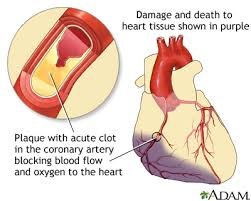ATHEROSCLEROSIS AND ARTERIOSCLEROSIS
Atherosclerosis and arteriosclerosis are the diseases of arteries. These diseases also lead to heart diseases. Atherosclerosis is commonly referred to as a "narrowing" of arteries. It is a chronic diseases in which there is accumulation of fatty materials, cholesterol or fibrin in arteries. When this condition is severe, arteries can no longer expand and contract properly, and blood moves through them with difficulty. Accumulation of cholesterol is the prime contributor to atherosclerosis. It results in the formation of multiple deposits called plaques within arteries. Plaques can form blood clots called thrombus within arteries. If a thrombus dislodges and becomes free-floating it is called an embolus.
**Arteriosclerosis is a general term describing any harding of arteries.It occurs when calcium is deposited in the walls of arteries. It can happen when atherosclerosis is sever.
MYOCARDIAL INFRACTION
The term myocardial infraction is derived from myocardial (the heart muscle) and infraction (tissue death). It more commonly known as a heart attack. It occurs when blood supply to a part of heart is interrupted and leads the death of heart muscles. Heart attack may be caused by blood clot in coronary arteries. It is a medical emergency and the leading cause of death for both men and women all over the world. Severe chest pain is the most common symptom of myocardial infraction and may in the form of sensation of tightness, pressure or squeezing. Pain radiates most often to left arm, but may also radiates to lower jaw, neck, right arm and back. Loss of consciousness and even sudden death can occur in myocardial infraction.
ATHEROSCLEROSIS AND RESULTING MYOCARDIAL INFRACTION.

Source of Photo
All data collected from book of Science.